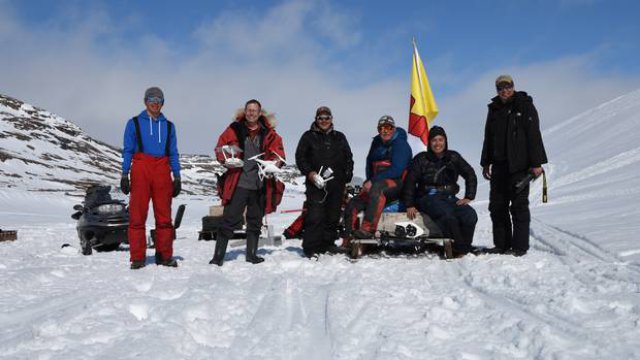 Kirt Ejesiak wasn’t very impressed with his first drone, purchased to take aerial photos of houses listed with his Property Guys real estate franchise in Iqaluit, Nunavut. But when a friend asked him to fly the drone over his roof to look for a leak, Mr. Ejesiak started thinking about other uses for unmanned aerial vehicles (UAV).
Kirt Ejesiak wasn’t very impressed with his first drone, purchased to take aerial photos of houses listed with his Property Guys real estate franchise in Iqaluit, Nunavut. But when a friend asked him to fly the drone over his roof to look for a leak, Mr. Ejesiak started thinking about other uses for unmanned aerial vehicles (UAV).
Three years later, Mr. Ejesiak has moved from hobby drones to top-of-the-line industrial mapping systems and is CEO and owner of Arctic UAV, a fledgling company offering aerial imagery services to individuals and companies. Although the company has just one project under its belt – taking aerial footage for the territory’s tourism department – Mr. Ejesiak is optimistic about its prospects. His company has so far acquired five drones, each costing more than $50,000, and is looking to buy more.
“The interest level is extremely high,” Mr. Ejesiak says.
The potential for using remotely-piloted aircraft systems in the Arctic seems as endless as the territories themselves – from surveying caribou and whale populations to monitoring sea ice to assisting with search-and-rescue operations – yet only a handful of northern-based companies offer the kind of high-quality industrial surveying and imaging services that Arctic UAV does.
GroundTruth Exploration, in Dawson City, Yukon, got its first drone three years ago to assess topographical features for firms doing mineral exploration work, says president Isaac Fage, but the company has since started offering other 3D imaging services.
“The applications have really exploded into a really diverse set of uses,” says Mr. Fage, who is also a lead drone operator. “Anybody who deals with anything spatial outdoors – likely there’s an opportunity and an advantage to using a UAV survey in a whole lot of situations that haven’t yet been realized.”
While there’s nothing stopping a company from south of the 60th parallel from parachuting into the territories to scoop up some of the work, Mr. Fage says that hasn’t really been happening.
“We always believe its [the competition] coming. But we haven’t really seen many sophisticated or aggressive companies really trying to tackle that market.”
The cost of buying commercial drones and the regulatory red tape in Canada are a couple of barriers for startups, but there’s more to it than that. Conditions in the Arctic present a very different playing field than in other parts of North America.
Marty Rogers, business director with the Alaska Center for Unmanned Aircraft Systems Integration (ACUASI), a research institute at the University of Alaska Fairbanks that’s been developing and testing drones for the past 15 years, says many companies from outside the North are caught off guard by the Arctic conditions.
“We have lot of experience with companies from other locations coming to the Arctic and attempting to fly and failing because their systems were never developed or tested in the Arctic and they’re just not prepared for the conditions, whether it’s the cold or wind or precipitation.”
On the other hand, says Mr. Rogers, more companies are realizing that the Arctic is a perfect training ground for drones – if they can fly there, they can fly anywhere. Advances in engine technology have resulted in fuel-injected systems that are more reliable and less susceptible to engine icing, Mr. Rogers explains, and new batteries can stand up to the cold much better than they could two years ago.
Despite the quick evolution of drone technology, Mr. Ejesiak says it wasn’t easy finding a system with the kind of high-definition surveying capabilities Arctic UAV was seeking.
“We literally scoured North America, Europe, Africa – looking for companies that are able to do things that we want to do.”
Both Arctic UAV and GroundTruth have a Swiss-made senseFly mapping drone, which can fly in winds up to about 40 km an hour. Mr. Ejesiak says his drones will operate to about minus-20, which is good for at least part of the year in the far North.
Beyond the technical aspects of flying in the North is the code of conduct for doing business there. Mr. Rogers says in his experience with ACUASI the companies that are the most successful are those that that invest the time to develop relationships with local communities.
“They understand the culture, they understand the limitations of the technology, they understand the thought process in the North [which is] much more around consensus and relationships than it is in other locations.”
Understanding the local culture shouldn’t be a problem for Arctic UAV, at least on paper. Mr. Ejesiak is Inuk and was born in Iqaluit. Seven of the nine-person team members are based locally (co-CEO Eli Turk is in Ottawa) and Mr. Ejesiak is particularly excited about his newest recruit, an 18-year old local high-school grad who the company just trained as a UAV pilot.
Photo: Arctic UAV Team members on a project at a territorial park outside of Iqaluit: Keane Sudlovenick, Steve Mongeau, Virgil Williams, Glenn Williams, Kirt Ejesiak & Michel Albert
(Arctic UAV)
Source: The Globe and Mail
